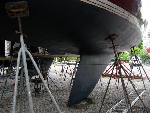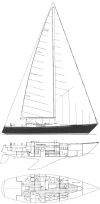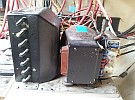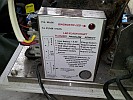Difference between revisions of "X-Dimension systems"
(→Headsail Roller Furling System) |
(→Starter Battery) |
||
| Line 368: | Line 368: | ||
==== Starter Battery ==== | ==== Starter Battery ==== | ||
| − | The Starter battery is a marine high-current AGM battery (not intended for deep cycle use). The battery is located in the port lazarette, next to the water heater, and under the propane tank. The starter battery is isolated by the Starter Battery Switch, currently located in the starboard lazarette, above the House batteries. ( | + | The Starter battery is a marine high-current AGM battery (not intended for deep cycle use). The battery is located in the port lazarette, next to the water heater, and under the propane tank. The starter battery is isolated by the Starter Battery Switch, currently located in the starboard lazarette, above the House batteries. (It is indended that this switch will be moved to the breaker panels above the galley sink some time in 2012.) |
When the Starter Battery Switch is on, power is supplied to the following circuits through the "always on" 50 amp "Engine" breaker at the top of the galley breaker panels: | When the Starter Battery Switch is on, power is supplied to the following circuits through the "always on" 50 amp "Engine" breaker at the top of the galley breaker panels: | ||
| Line 377: | Line 377: | ||
* Engine temperature sensors and oil pressure sensor | * Engine temperature sensors and oil pressure sensor | ||
| − | The Starter Battery Switch also sends power to the following | + | The Starter Battery Switch also sends power to the following circuit through the "always on" 10 amp "Fuel Pump" breaker. |
* Electric inline Fuel Pump located under port settee, just aft of the fuel tank. | * Electric inline Fuel Pump located under port settee, just aft of the fuel tank. | ||
Revision as of 08:34, 6 August 2012
This is an exhaustive list of X-Dimension's various subsystems.
Contents
- 1 Specifications
- 2 Rigging
- 3 Deck
- 4 Machinery
- 5 Electrical
- 6 Electronics
- 7 Magnetic Compasses
- 8 Safety
Specifications
Specifications provided by David Collins:
Length Over All (LOA): 43.4 ft
Waterline Length: 35.9 ft
Maximum Beam: 13.0 ft
Draft: 7.75 ft (7 ft 9 in)
(Note: original draft was 7.50 ft
but keel was modified by original owner)
Displacement: 22,000 lbs
PHRF/NE Rating: 72 base;
as sailed 2011: 87 racing, 90 cruising
Powerplant: Perkins 4-108 50hp (new in 1989)
Mast and rig: Sparcraft tapered 2-spreader /
discontinuous rod (new in 2007)
Fuel Capacity: 40 gal
Water Capacity: 80 gal
C&C Custom 43 specifications, but actual dimensions may differ. For example, mast was replaced in 2007 and keel was modified by previous owner, Blair Vedder. The values below should not be used without independent verification.
Hull Type: Fin Keel
Rig Type: Masthead Sloop
LOA: 43.33' / 13.21m
LWL: 35.00' / 10.67m
Beam: 12.83' / 3.91m
Listed SA: 901 ft2 / 83.7 m2
Draft: 7.00' / 2.34 m
Displacement: 21314 lbs./ 9668 kgs.
Ballast: 9980 lbs. / 4527 kgs.
Designer: Cuthbertson & Cassian
Builder: C&C Yachts (CAN)
Construct.: FG
First Built: 1971
Last Built:
# Built:
RIG DIMENSIONS
I: 56.00' / 17.07m J: 18.80' / 5.73m
P: 50.00' / 15.24m E: 15.00' / 4.57m
PY: EY:
SPL: ISP:
SA(Fore): 526.40 ft2 / 48.90 m2
SA(Main): 375.00 ft2 / 34.84 m2
Total SA: 901.40 ft2 / 83.74 m2
SA/Disp: 18.83
Est. Forestay Len.: 59.07' / 18.00m
Rigging
Standing Rigging
Mast
- Total length of mast: 63' 11.5"
- Height of mast above deck: 57' 0.5"
- Height of lower spreader above deck: 22' 0.5"
- Height of upper spreader above deck: 41' 2.75"
- Height of foredeck light above deck: 25'
- Distance from base of mast to deck: 6' 11"
- Distance from base of mast to foredeck light: 31' 11"
Backstay Adjuster
Sailtec Integral Backstay Adjuster (Model 10SI), brochure on web (no operating instructions)
When sailing upwind, the backstay should be adjusted so that the piston is approximately 2 inches from the white gauge on the shaft (2" minimum). Cross check the headstay sag. In moderate winds, the headstay should have very little sag.
Headsail Roller Furling System
Harken Mark III (Unit Size 2)
Owners Manual can be found at [1]
Sails Kept on the Boat
General: The [Owners "Helpful Hints"] has various advice in the pages 4-5 "Sail Control" section.
Mainsail
Lazy Jack Installation Manual (no title) for the E-Z-JAX mainsail furling system. Page 4 of this manual gives operating instructions; the rest of the manual is e.g. parts identification and installation instructions.
The mainsail is normally kept furled on the boom with a sail cover.
Headsails
The #3 Genoa (approximately 135%) is normally kept on the roller furler.
The #1 Genoa is a carbon-reinforced racing sail that is normally kept in the forward v-berth and used for racing.
Spinnaker
The Asymmetric Spinnaker is normally kept in a spinnaker bag in the forward v-berth. It is equipped with a snuffer.
Note: Spinnaker pole storage on toe-rail requires periodic checking even on sails not using spinnaker, because of its current (Sep 2011) shortened length (see Ongoing Problems list.)
Current Inventory of Sails at the Pavilion (as of 02/09/2012)
Mainsails
Working mainsail (tied with sail ties, but not in a sail bag)
Old mainsail (in blue North Sails bag)
Jibs and Genoas
Genoa #1 (a carbon-reinforced racing sail, tied with sail ties but not in a sail bag)
Genoa #2 (in brown Sperry Sails bag labeled "new #3 Genoa") (note: This is an estimate based on the fact that the #3 Genoa is normally kept on the furler and accounted for below).
Genoa #3 (tied with sail ties, but not in a sail bag)
Storm Jib (in white sail bag with faded lettering)
Asymmetric Spinnaker
Working Asymmetric Spinnaker (in blue spinnaker bag, equipped with a snuffer)
Symmetric Spinnakers
0.5 oz Tri Radial Symmetric Spinnaker (in North Sails blue bag dated 1979)
0.75 oz Symmetric Spinnaker (in North Sails blue bag)
0.75 oz Symmetric Spinnaker (in yellow UK Sailmakers bag)
1.5 oz Star Cut Symmetric Spinnaker (in yellow sail bag)
1.5 oz Tri Radial Symmetric Spinnaker (in blue sail bag)
Deck
Winches
When delivered to MIT in August 2011, X-Dimension sported 16 winches. After winter refurbishment January 2012, X-Dimension has 14 winches.
fore mast port (#1) - Barient 22 fore mast stbd (#2) - Barient 20 mast port (#3) - Barient 28 boom (#4) - Barient 10H aft mast port (#5) - Barient 22 aft mast stbd (#6) - Barient 22 companionway port (#7) - Barient 22 companionway stbd (#8) - Meissner 27 traveler port (#9) - Barient 10P traveler stbd (#10) - Barient 10 fore cockpit port (#11) - Barient 32 fore cockpit stbd (#12) - Barient 32 aft cockpit port (#13) - Barient 35 aft cockpit stbd (#14) - Barient 35
Companionway Hatch Removal
- Remove Forward Hatch Stop by removing three wood screws on the ceiling of the coach roof just forward of the companionway opening. Slide the stop out between the hatch and the coaming.
- Remove the wood screws holding the hatch rails to the hatch. All screws except the furthest forward screws will be accessible. Once these are removed, the rails may be rotated outboard and the hatch slid aft to access the last two screws. Remove the hatch.
Traveler
The traveler is built of Harken "big boat" and HL (high load). The purchase is 4:1.
- track: 5 foot long Harken 32mm
- end controls: Harken 5170 with cam cleat
- car: Harken T3242B.HL
Machinery
Power Train
The "Engine & Drive" section, pp. 5-6, of the previous owner's "Useful Info" has some data about the power train and how to operate it.
The Perkins engine SHOP and PARTS manuals are available electronically as listed in the "documents list".
Engine
- Perkins 4-108 diesel (4-cyl, 50-hp), new to X-Dimension in 1989
- Serial # ED70058U630095P (mfg 1987)
(ED=4.108; 70058=parts list Nr; U=mfg UK; 630095=engine S/N; P=1987)
These Perkins manuals may be helpful:
- Perkins Marine Diesel Engines Operating Manual
- Workshop manual for 4.108 4.107 and 4.99 diesel engines
- Perkins Parts Book
- Perkins Engine Wiring
Transmission
- Newage gearbox, approx 2001
- PRM DELTA Gearbox; P/N=DELTA20, Serial #=C913041, Work Order #=R00629 (ref. loose packing sticker aboard)
- Manual: PRM DELTA MARINE GEARBOX Workshop Manual
Coupler
- Bolts in coupler were replaced May 2012
Stuffing Box
- Nearly no leakage from stuffing box as of Nov 2011
- Stuffing box adjusted Jun 2012 to allow slow drip during operation
Cutlass Bearing
- Less than 1/32" play in cutlass bearing as of May 2012
Propeller
- Max-Prop feathering 2-blade propeller, 17-inch
Muffler
- Vernalift (unidentified model & mfgr) Thomasville, GA
Fuel System
- Emergency fuel cut-off: TBD
- Filler deck fixture located port toe rail
- Filler filtering: none
- Primary fuel filter / water separator : on stbd lazarette bulkhead; Racor 500 FG S/S
- Fuel inlet screen: TBD
- Primary fuel lift pump: TBD
- Fuel Tank:
- Capacity: 40-gal, giving approx 288 miles @ 2000 RPM using 0.9 gal/hour at 6.5 kt
- Material/when Installed/Replaced: TBD
- Fuel gauges:
- There is a mechanical fuel gauge located under the port main saloon bunk cushion. It is quite accurate when the boat is level.
- The electrical fuel gauge(s) are not operative as of May 2012.
Fluids and Filters
- oil filter: WIX 51305 / NAPA 1305 / FRAM CH836PL
- located aft end of engine, replaced 11jun12
- fuel filter: Racor 500FG S/S
- located in starboard lazarette, replaced 07jun12
- fuel filter: WIX 33166 / FRAM C1191A / NAPA 3195
- located starboard aft end of engine, replaced ?
- raw water filter: metal strainer
- located in starboard lazarette, cleaned 11jun12
- raw water impeller: jabsco
- located port foreward end of engine, replaced 11jun12
- oil: ?
- ? quarts required
- coolant: ?
- ? gallons required
Steering
Helm
- The steering wheel is trapped by the fiberglass cover in the center of the cockpit. Remove this cover to remove the steering wheel.
- The emergency tiller is a long steel bar inserted into a square hole beneath an inspection portal in the fiberglass cover aft of the helm. The tiller is kept in the starboard lazarette.
Rudder
- When hauled in Nov 2011, the rudder was saturated with water. 4 holes were drilled to drain it over the winter, then plugged in May 2012.
- The rudder was pulled Dec 2011 and the shaft repacked. Prior to this time there was a steady trickle of water entering the boat from the rudder post.
Thru-Hulls
As delivered to MIT in August 2011, X-Dimension had 11 thru-hulls.
After Winter 2011/2012 refurb, the thru-hulls are:
- port v-berth 1.5" - blackwater out
- port forward of keel 1" - greywater out
- port mid-keel 0.75" - toilet in
- stbd mid-keel 0.75" - galley seawater
- port mid-keel 2" - speed impeller
- stbd mid-keel 2" - depth transceiver (epoxied in place)
- stbd aft of keel 1.5" - galley greywater out
- stbd mid cockpit 1" - engine in
- stbd cockpit 1.5" - scuppers
- port cockpit 1.5" - scuppers
- port cockpit 1/2" at waterline - propane drain
There are two vestigial thru-hulls, one for an impeller and the other for a depth transducer. These are located just aft of the main cabin forward bulkhead, beneath the cabinets.
Bilge Pumps
There are two electric bilge pumps and two manual bilge pumps. The primary electric is a diaphram pump located in the cabinet beneath the nav station. The secondary is a submersible located in the center portion of the bilge well. Float switches for these pumps are located in the bilge well. The primary manual is located in the port bulkhead of the cockpit just forward of the helm. The secondary manual is located under the floorboards of the foul weather gear locker. It can be operated without removing the floorboards.
Individual auto-manual-off controls for each electric pump are located port of the nav station. These are energized by the always-on bilge pumps breaker in the main breaker panel.
All bilge hoses exit the boat starboard of center at the transom.
See the previous owner's Useful Info writeup, page 7, section headed "Bilge Pumps" for the previous configuration.
Primary Electric
- Jabsco Model 34600-Series Electric Diaphragm Bilge Pump
- Rule-a-Matic float switch
Secondary Electric
- Rule 1500 GPH submersible bilge pump
- Rule-a-Matic float switch
Primary Manual
- Whale Gusher 10
- repair kit is West Marine part # 255658 OR 135038
Secondary Manual
- Whale
- repair kit is
Strum Box
- strum boxes are 1 1/2" West Marine part # 100729, Whale mfg. part # SB5865
Head
The head is a hand-operated marine toilet unit connected to a 25 gallon expanding holding tank. The output from the toilet goes into the holding tank. From the holding tank there are two hoses, one to a pump-out fitting on the deck, the other to a thru-hull under the forward cabin sink.
The forward facing panel beneath the sink in the forward cabin can be removed for access to the thru-hull valve.
The seawater in thru-hull is located port of center under the main cabin floorboards, just aft of the mast. A small mesh strainer is located inline soon after the thru-hull valve.
The toilet is Jabsco model 29090-2000 (compact bowl & seat).
Refrigerator / Ice Box
The refrigerator / ice box is located beneath the galley counter and can be accessed via two hinged hatches. There is a shelf in the refrigerator compartment that will accommodate ice blocks.
The refridgerator compressor is made by Alder/Barbour. The exact model is unknown but appears similar to the ColdMachine model.
The compressor runs on the 12V house battery and is located in the starboard lazarette outboard of the house battery box. The compressor is powered by a 15A breaker on breaker panel 2 above the galley sink. A thermostat in the ice box controls operation of the compressor.
The compressor has two blade type fuses located at the outboard aft corner:
- 15A Main
- 5A Fans
A diagnostic LED is on the rear panel; the cadence of the LED's flashing indicates the specific problem with the compressor.
See also: File:Adlerbarbour manual.pdf Operating manual for Alder/Barbour refridgeration systems
Stove
Freshwater
Electrical
12-volt
Batteries
There are two independent sets of batteries on the boat. The "Starter" battery is used for starting the engine. The "House" batteries supply power to most of the rest of the electrical equipment onboard.
Both banks of batteries are charged by the alternator through an ARCO BI-1602 battery isolator.
Starter Battery
The Starter battery is a marine high-current AGM battery (not intended for deep cycle use). The battery is located in the port lazarette, next to the water heater, and under the propane tank. The starter battery is isolated by the Starter Battery Switch, currently located in the starboard lazarette, above the House batteries. (It is indended that this switch will be moved to the breaker panels above the galley sink some time in 2012.)
When the Starter Battery Switch is on, power is supplied to the following circuits through the "always on" 50 amp "Engine" breaker at the top of the galley breaker panels:
- Starter button on binnacle (connected to starter solenoid)
- HEHR voltage regulator unit
- Engine instruments in cockpit instrument panel
- Engine temperature sensors and oil pressure sensor
The Starter Battery Switch also sends power to the following circuit through the "always on" 10 amp "Fuel Pump" breaker.
- Electric inline Fuel Pump located under port settee, just aft of the fuel tank.
House Batteries
The House battery bank consists of two mixed-use AGM batteries (intended for starting and/or deep cycle use), connected in parallel. These batteries are located in the starboard lazarette, just aft of a bulkhead that separates the lazarette from the main cabin. The House battery compartment is usually covered by a wooden tray that contains winch handles.
Misc
The best measure of the status of the house battery is to use the switch above the galley sink and toggle it to the right when the engine is stopped (i.e., not charging) and the battery switch is set to "House". There is a voltmeter near the switch that should indicate at about the red/green line. When the engine is running, the indicated voltage should ba approximately 14V. Note that the switch sometimes has a poor contact and needs to be jiggled a little to have it work. Note that the ammeter in the engine instrument cluster in the cockpit is not working.
110-volt
The 110v system is inoperative as of May 2012.
- The shore power connector has been disconnected.
- All the 110v breakers have been removed.
- The wiring to the 110v outlets is still in place but is disconnected at the breaker panels.
- Three 110v outlets (non-GFCI) are located:
- in the head
- just forward of the stove
- starboard locker, just forward of the mast
Note that there is an 800 watt DC-to-AC inverter on board.
Anti-Electrolysis
- There are two zincs clamped to prompt shaft, new as of May 2012
- There is an external zinc "guppy" that is deployed at the stern while the boat is on the mooring or at the dock.
Lightning Dissipation
- The boat is fully grounded, with a woven copper strip connecting the mast, shrouds, and engine block.
- The only bonding from the grounded systems to salt water is via the propeller shaft via the engine block.
Electronics
Fixed mount GPS
- Garmin GPSMap 541 Chartplotter
- mounted in cockpit bulkhead, port of companionway
- antenna is located on the cockpit rail port of center aft of the helm
- communicates with GMI 10 display, wind instruments and depth sounder via NMEA 2000 network
- sends position data to VHF500dsc radio (one-way communication) via NMEA 0183 data connection.
Garmin GMI 10 Sailing Instrument
- mounted in cockpit bulkhead, port of companionway
- can display various parameters, such as depth, apparent wind speed and angle, true wind speed and direction, speed over ground, etc.
- Communicates with GPSMap 541, wind instrument & depth sounder via NMEA 2000 network
Wind
- Garmin GWS 10
- senses wind speed and angle
- communicates with GMI 10 display and GPSMap 541 via NMEA 2000 network
Depth Sounder
- Garmin Thru-Hull Intelliducer (depth sounder)
- located starboard of center aft of forward main cabin bulkhead inside of cabinet
- communicates with GMI 10 display and GPSMap 541 via NMEA 2000 network
NMEA 2000 network
The NMEA 2000 network on X Dimension entirely consists of instruments, cables and connectors manufactured by Garmin. All connectors are NMEA 2000 "Micro" connectors. The network consists of a backbone that runs from the cabinet on the port side of the companionway to the top of the mast. The backbone requires a terminator at either end. The backbone also requires 12v DC power to operate; this is supplied by the yellow power cable.
The network consists of a backbone, and various "drops" that interface via "T-connectors". The drops on the network currently are:
- Garmin GMI 10 display
- Garmin GPSMap 541 chartplotter
- Yellow 12v DC power cable
- Garmin Intelliducer depth sounder
- Garmin GWS 10 wind instrument
The GMI 10 and GPSMap 541 have their own power connections. The depth sounder and wind instruments draw power from the network.
The network cables have five conductors:
- Red: +12v DC
- Black: Ground
- White: Data+
- Blue: Data-
- bare wire: shield
Radar
- JRC RADAR1000 mounted display
- installed in cubby over Nav Station table
- antenna mounted on pole on port quarter.
Radios
Fixed VHF
- West Marine VHF500dsc Fixed Mount Marine Radio
- Receives GPS data from Garmin GPSMap 541 via NMEA 0183 connection
- MMSI Number: 338137891
- Operator's Manual: File:VHF500 English.pdf
Handheld VHF
West Marine VHF55 VHF Radio
AM/FM/CD Stereo
Dual MXD25
Inlcudes 1/8" auxilary audio input jack and USB charger jack on front panel.
Magnetic Compasses
- Binnacle Compass
- make and model: TBD
- has not been swung (Sep11)
- rebuilt Apr12
- illuminated by "INST LIGHTS" switch on navigation lights switch panel
- Starboard Bulkhead Compass
- make and model: Plastimo "Contest" (Classe B)
- "tactical" compass card
- Starboard and Port Rail Compasses
- make and model: Danforth "Corsair"
- Nav Station Compass
- make and model: Suunto Type B-110
Safety
Fire Extinguishers
- hand-held: 3 ABC extinguishers purchased Sep 2011
- fixed mount: halon tank directly beneath cockpit
PFDs
- 4 inflating PFDs
Throwables
- 4 throwable cushions
- Lifesling man overboard recovery system
Harnesses, Jacklines, Tethers
- ? harnesses with tethers
- ? jacklines






